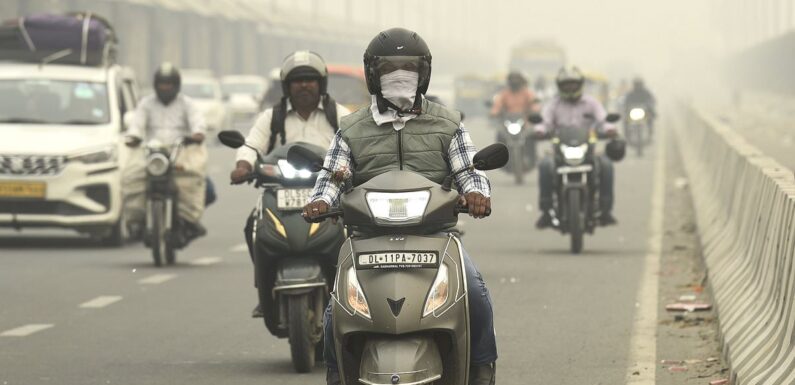
Air pollution in Delhi reaches the near-maximum level possible – 100 times WHO healthy limits – as its annual smog season begins
- Schools were closed and non-essential construction was banned as the air quality index in the city reached almost 500
Air pollution reached the near-maximum level possible in India’s capital New Delhi today as the city was blanketed by a thick layer of toxic haze, marking the start of the annual smog season.
Schools were closed and non-essential construction was banned as the air quality index in the city reached almost 500 – 100 times the limit deemed to be healthy by the World Health Organization.
Air quality in Delhi had worsened over the last week, attributed to a dramatic rise in farmers in the neighbouring states of Punjab and Haryana burning their fields during the crop planting season, as well as winds that brought the pollutants into the capital and a decrease in temperatures keeping the particles trapped.
Delhi chief minister Arvind Kejriwal announced late yesterday that all primary schools would be closed across the capital for at least two days.
Many of the capital’s 33 million residents complained of irritation to the eyes and itchy throats as the air turned a dense grey.
Smog hangs over the city skyline in New Delhi, India, on November 3, 2023
Traffic moves on a road enveloped by fog and smog in New Delhi, India, on November 3, 2023
Doctors in the city said they had started to notice the damaging impact of pollution on the capital’s residents.
Pollution levels in Delhi in October were at their worst since 2020, according to the central pollution control board.
The city’s government has said that it has a pollution action plan, but it appears to have made little difference as the noxious grey smog engulfs the megacity every year, making life a misery for its inhabitants.
Methods undertaken by the AAP government to try to alleviate the problem have included sprinkling of water on roads to lower the amount of dust and constructing of two ‘smog towers’, which were built to clean the air but have been deemed largely ineffective by scientists.
Delhi is regularly ranked the most polluted city in the world.
Smoke from farmers burning crop stubble, vehicle exhaust and factory emissions combine every winter to blanket Delhi in a choking haze.
According to this year’s air quality life index, compiled by the University of Chicago’s energy policy institute, the people of Delhi could have their lives shortened by 11.9 years due to the poor air they breathe.
Traffic moves on a road enveloped by fog and smog in New Delhi, India, on November 3, 2023
Smog hangs over the city skyline in New Delhi, India, on November 3, 2023
While junior schools in the capital were ordered shut for Friday and Saturday, they were open in the suburbs and children were forced to bring out masks that had been put away since the COVID-19 pandemic and wear them as they boarded their school buses.
Visible smog is a burden for Delhi residents through much of the year but the problem peaks at the start of winter around the Hindu festival of Diwali.
The holy day coincides with the weeks when tens of thousands of farmers across north India set fire to their fields to clear crop stubble from recently harvested rice paddies.
That practice is one of the key drivers of Delhi’s annual smog problem, worsening the impact of vehicle and industrial emissions.
It persists despite efforts to persuade farmers to use different clearing methods and threats of punitive action for those who defy burning bans.
Eye-stinging and lung-burning smog peaks from October to February when colder air traps pollution, with residents advised to wear face masks outside at all times.
People walk along the Kartavya Path near India Gate amid heavy smog conditions in New Delhi on November 3, 2023
People walk along the Kartavya Path near India Gate amid heavy smog conditions in New Delhi on November 3, 2023
India is hosting the Cricket World Cup and organisers have banned fireworks at matches in Mumbai and Delhi to avoid compounding hazardous air pollution levels.
Bangladesh and Sri Lanka are due to play in Delhi on Monday, with little likelihood of the air clearing for their match.
India captain Rohit Sharma told reporters on Wednesday that the situation was ‘not ideal’ for the tournament.
‘Everyone knows that,’ he said. ‘Looking at our future generation… it’s quite important that they get to live without any fear.’
A Lancet study in 2020 attributed 1.67 million deaths to air pollution in India during the previous year, including almost 17,500 in the capital.
The average city resident could die nearly 12 years earlier than expected due to air pollution, according to an August report by the University of Chicago’s Energy Policy Institute.
India is heavily reliant on polluting coal for energy generation. Its per capita coal emissions have risen 29 per cent in the past seven years and it has shied away from policies to phase down the dirty fossil fuel.
Source: Read Full Article





